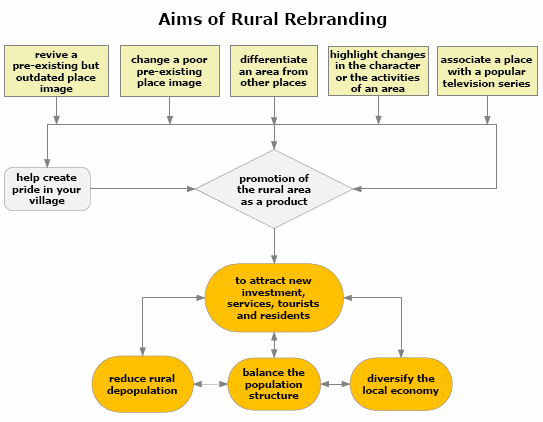Rural Rebranding - the reinvention of rural places
 |
A brand image generates a unique set of ideas, feelings and attitudes in people. To remain competitive, large companies sometimes overhaul or completely replace their images and relaunch themselves as fresh corporate brands. Similarly, competition between rural places to attract new investment, services, tourists and residents has led many rural areas to establish completely new brand identities.
Rebranding an area can help people become aware of the existence of new place products and recognize that they possess real benefits, style and culture. It can help differentiate an area from other places and hence greatly assist its promotion as a product. Well-documented UK examples of the practice include rural brands with slogans such as 'Last of the Summer Wine Country', associating an area with a popular television series.
Rural areas are often characterised by depopulation and an ageing population and this has frequently led to media portrayals of their being associated with economic and social deprivation, and a lack of local shops, civic amenities and services. As a consequence, they have increasingly needed to reposition themselves as centres of leisure and amenity rather than of production of agricultural products. However, there has been little desire to completely discard imagery connected with an agricultural heritage. Rural landscape and crafts are fundamental local resources, intimately related to the agricultural heritage.
The Problems Involved
Rural rebranding changes fundamentally the character of an area. This may be highly controversial because the changes involved might result in the importation of financially well off residents, business infrastructures, and cultural and leisure facilities more suited to better off people than to poorer pre-existing inhabitants (who might be driven out by rising property prices and rents). The challenge for the marketing manager is therefore to merge multiple identities within a specific location into a concise and easily understood brand which appeals to business investors and tourists but without compromising traditional rural culture and the distinct pre-existing characteristics of the area.
The Process of rebranding
The main steps in rebranding comprise name creation and registration, the design of a logo and associated visual image, market research, and advertising. More fundamentally, rebranding might be seen either as a tactical issue whereby the new brand is operationally attached to the place product, or as an important strategic matter in which all the processes of the rural development authority revolve around the construction and development of the new brand.
Priorat Rural Rebranding Case Study
Priorat is a predominantly rural, sparsely populated region situated 120 kilometres southwest of Barcelona.
 |
| Gratallops - the centre of the wine revival in Priorat |
Priorat has a famous winemaking history that began in the 12th century with the Carthusian monks of Scala Dei. In 1900 an outbreak of phylloxera devastated the region's vineyards, and mass tourism on the coast in the 1960s accelerated the rural decline. Twenty years ago, the Priorat region was on the verge of extinction, with grape prices so low that this was one of Spain's most impoverished regions.
It took a few visionaries to realise Priorat's potential. Most agree René Barbier initiated the Priorat revival. In the 1980s he established a co-operative that put its first wine on the market in 1991. From that first release, the New York Times published an article extolling the virtues of the Priorat wines and prices soared, with wines commanding more than $300 a bottle. In barely 15 years, the wines from Priorat have gone from obscurity to the most expensive in Spain.
Tourism associated with Priorat's wine revival has led to the establishment of high quality restaurants operated by the wineries. This has helped to create a 'Priorat' quality brand that is now attached to other products in the region. Tourism, coordinated by the Leader Community Initiative, now operates as a basic promotional and marketing tool for other quality food, cultural and agriculture products. These include small shops specialising in traditional products, living museums converted from old warehouses and mills, guided tours to the wineries and walks through the vineyards. Wine and gastronomic tourism have thus combined to encourage local development and the agricultural recovery of a region traditionally considered as marginal.
The processes leading to the revival of the Priorat Region
 |
